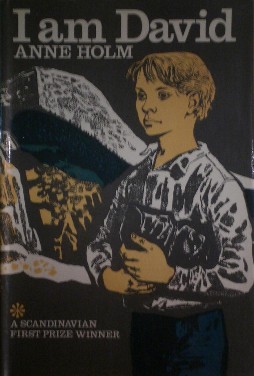I Am David facts for kids

First UK edition
|
|
| Author | Anne Holm |
|---|---|
| Original title | Jeg er David |
| Translator | L. W. Kingsland |
| Country | Denmark |
| Language | Danish |
| Genre | Children's, historical novel |
| Publisher | Gyldendal Methuen (UK) |
|
Publication date
|
1963 |
|
Published in English
|
1965 |
| Media type | Print (hardback and paperback) |
| Pages | 191 |
| ISBN | 0-15-205161-9 (first English edition, hardback) |
| OCLC | 54006814 |
| LC Class | PZ7.H7322 Iae 2004 |
I am David is an exciting adventure novel written by Anne Holm in 1963. It tells the story of a brave young boy named David. He escapes from a difficult camp in Eastern Europe. His goal is to travel all the way to Denmark, a free country.
On his long journey, David meets many different people. They help him learn about life outside the camp. He discovers the world's beauty and kindness. The book was first written in Danish. It has been translated into many languages. In the United States, it was first called North to Freedom. Later, it was also published as I am David. A movie based on the book was made in 2003.
Contents
David's Escape and Journey
David is 12 years old. He has lived in a camp for as long as he can remember. The people who run the camp are called "them." David was a strong and smart boy. He was taken from his mother and put into this tough place. His only friend in the camp, Johannes, had passed away.
One of the guards helps David escape. This guard gives him soap, bread, water, and a compass. David must travel south to Salonika. From there, he needs to find a boat to Italy. Then, he must go north to a free country with a king.
First Steps to Freedom
David finds a truck heading to Salonika. He secretly climbs inside. He eats some of the food he found. When the truck stops, he jumps out. He then finds a boat marked "Italy" and sneaks aboard. After hiding for a few days, he is discovered. Luckily, an Italian sailor decides to help him. The sailor lowers David down the ship's side using a lifebelt. David floats to land and falls asleep.
Learning About the World
After resting, David finds a cave to hide in during the day. He decides to visit a nearby town. He wants to learn about life outside the camp. To his surprise, someone gives him a loaf of bread. He also finds a newspaper. He uses it to practice reading.
David visits the town daily for a while. He pretends he works for a circus. This helps explain why he speaks many languages. It also explains why he is traveling alone. But then he hears people talking about him. He quickly leaves the town and heads north.
Helping Others and Discovering Beauty
As David travels, he helps people he meets. Sometimes, they give him money. He slowly starts to change. He learns to interact with others. He also discovers the beauty of the world around him.
He saves a girl named Maria from a fire. She was trapped in a shed. David stays with Maria's family for some time. He sees a globe there and learns about different countries. David's past experiences worry Maria's parents. He overhears them talking about him. He writes them a letter and leaves. He continues his journey north. Later, he sees an ad in a newspaper. Maria's family is looking for him. They offer him a home and say they understand him.
A New Understanding
David has been praying to the "God of green pastures and still waters." A priest explains that there is only one God. This helps David understand more about faith.
He later meets Sophie, an artist from Switzerland. She asks to paint his picture. Sophie invites David to her house for lunch. There, David sees a picture of a woman from Denmark. Sophie tells him the woman's husband and son, also named David, were killed. But a guard helped the woman escape.
David then realizes something amazing. He needs to go to Denmark to find that woman. She is his mother! He also understands that the guard, who became the commandant, saved him. The guard had loved David's mother. But because she did not love him back, he did not tell her that David was still alive.
The Final Journey
When winter arrives, David is traveling through the mountains. A farmer takes him in. David works for the farmer during the harsh winter. He is thankful for shelter in the stable at night. The farmer's dog, King, keeps him company.
David knows he must escape when the snow melts. The farmer plans to hand him over to the police. David makes a hole in the stable. He digs a tunnel and escapes. King the dog follows him. Later, King sacrifices himself to help David cross the border into East Germany.
David continues his journey through Denmark. He reaches Copenhagen. He finds his mother's address in a phone book. Tired but determined, he knocks on the door. He introduces himself to his mother. She instantly recognizes him as her son.
Awards and Recognition
I am David has received several awards:
- Crystal Heart Award
- Heartland Film Festival
- Lewis Carroll Shelf Award
- American Library Association Notable Book
- Best Scandinavian Children's Book (awarded in 1995)
- Boys Club of America Junior Book Award Gold Medal

